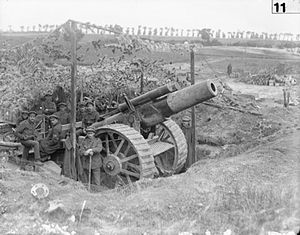
8-inch Howitzer Mk I on the Somme, July 1916
During World War I, the 67th Siege Battery was a unit of the British Royal Garrison Artillery that played a significant role in the artillery operations on the battlefields. Artillery was a crucial component of warfare during this period, and siege batteries were responsible for operating heavy guns to provide support in sieges and major offensives.
The 67th Siege Battery took part in several major battles during the war, and their actions contributed to the Allied efforts on the Western Front. Some of the notable battles and operations where the 67th Siege Battery was involved include:
- Battle of the Somme (1916): The 67th Siege Battery likely participated in the Battle of the Somme, which was one of the largest and bloodiest battles of the war. The Somme offensive aimed to break through the German lines and relieve pressure on the French forces at Verdun. The battery would have been involved in the intense artillery bombardments that preceded the infantry assaults.
- Battle of Passchendaele (Third Battle of Ypres) (1917): This was another major offensive in which the 67th Siege Battery may have taken part. The battle was characterized by the extremely difficult conditions of the Flanders mud, which posed additional challenges for artillery operations.
- Spring Offensive (Kaiserschlacht) (1918): The German Spring Offensive was a series of offensives launched in 1918 with the aim of breaking the stalemate on the Western Front. The 67th Siege Battery would have been involved in counter-battery fire, trying to neutralize enemy artillery to protect their own troops.
- Hundred Days Offensive (1918): The 67th Siege Battery likely participated in the final series of offensives by the Allies that eventually led to the end of the war. During this period, the British and their allies made significant gains and pushed the German forces back.
The role of a siege battery was to operate heavy artillery pieces, such as howitzers and mortars, which were designed to destroy enemy fortifications and strongpoints from a distance. These guns were usually large and required substantial manpower and logistics to move and operate effectively. Siege batteries were critical in softening enemy defenses before infantry assaults and played a significant role in breaking the stalemate of trench warfare.
It is important to note that specific details about the actions of individual units, including the 67th Siege Battery, may not be widely documented, and historical records can sometimes be incomplete or contradictory. However, their role, like that of other artillery units during World War I, was undoubtedly essential in shaping the outcomes of major battles and offensives during the conflict.
